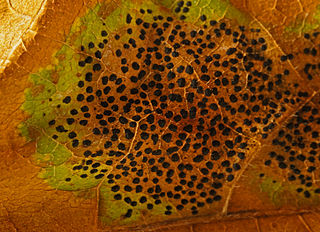
Acer campestre, known as the field maple, is a flowering plant species in the family Sapindaceae. It is native to much of continental Europe, Britain, southwest Asia from Turkey to the Caucasus, and north Africa in the Atlas Mountains. It has been widely planted, and is introduced outside its native range in Europe and areas of USA and Western Australia with suitable climate.

Acer negundo, the box elder, boxelder maple, Manitoba maple or ash-leaved maple, is a species of maple native to North America. It is a fast-growing, short-lived tree with opposite, compound leaves. It is sometimes considered a weedy or invasive species, and has been introduced to and naturalized throughout much of the world, including in South America, Australia, New Zealand, South Africa, much of Europe, and parts of Asia.

Canadian cuisine consists of the cooking traditions and practices of Canada, with regional variances around the country. First Nations and Inuit have practiced their culinary traditions in what is now Canada since at least 15,000 years ago. The advent of European explorers and settlers, first on the east coast and then throughout the wider territories of New France, British North America and Canada, saw the melding of foreign recipes, cooking techniques, and ingredients with indigenous flora and fauna. Modern Canadian cuisine has maintained this dedication to local ingredients and terroir, as exemplified in the naming of specific ingredients based on their locale, such as Malpeque oysters or Alberta beef. Accordingly, Canadian cuisine privileges the quality of ingredients and regionality, and may be broadly defined as a national tradition of "creole" culinary practices, based on the complex multicultural and geographically diverse nature of both historical and contemporary Canadian society.

Verticillium is a genus of fungi in the division Ascomycota, and are an anamorphic form of the family Plectosphaerellaceae. The genus used to include diverse groups comprising saprobes and parasites of higher plants, insects, nematodes, mollusc eggs, and other fungi, thus the genus used to have a wide-ranging group of taxa characterised by simple but ill-defined characters. The genus, currently thought to contain 51 species, may be broadly divided into three ecologically based groups - mycopathogens, entomopathogens, and plant pathogens and related saprotrophs. However, the genus has undergone recent revision into which most entomopathogenic and mycopathogenic isolates fall into a new group called Lecanicillium.

Silver leaf is a fungal disease of trees caused by the fungal plant pathogen Chondrostereum purpureum. It attacks most species of the rose family Rosaceae, particularly the genus Prunus. The disease is progressive and often fatal. The common name is taken from the progressive silvering of leaves on affected branches. It is spread by airborne spores landing on freshly exposed sapwood. For this reason cherries and plums are pruned in summer, when spores are least likely to be present and when disease is visible. Silver Leaf can also happen on poming fruits like apples and pears. Plums are especially vulnerable.
Rhytisma vitis is a species of fungus in the family Rhytismataceae. It was described by Lewis David de Schweinitz in 1832.

The Rural Municipality of Maple Creek No. 111 is a rural municipality (RM) in the Canadian province of Saskatchewan within Census Division No. 4 and SARM Division No. 3. It is located in the southwest portion of the province.

The Rhytismataceae are a family of fungi in the Rhytismatales order. It contains 55 genera and 728 species.

Propolis is a genus of fungi in the family Rhytismataceae. The genus contains about 14 species. This is not to be confused with bee propolis, also known as 'bee glue', which is a byproduct of an active beehive and is not a fungus.
Vladracula is a genus of fungi within the Rhytismataceae family.

Zeus is a fungal genus within the family Rhytismataceae. It is a monotypic genus, containing the single species Zeus olympius, originally discovered in 1987 on Mount Olympus in Greece. Fruit bodies are yellow discs that grow in the decaying wood of Bosnian pine trees.
Coccomyces clavatus is a species of foliicolous fungus found on fallen phylloclades of Phyllocladus alpinus in New Zealand.

Coccomyces dentatus is a species of fungus in the family Rhytismataceae. A widespread species, particularly in temperate areas, it colonizes the dead fallen leaves of vascular plants, particularly oak and chestnut. The fungus apothecia, which form in the epidermal layer of the leaf host, resemble dark hexagonal spots scattered on a multi-colored mosaic pattern bounded by thin black lines. When mature, the apothecia open by triangular flaps to release spores. The anamorph form of C. dentatus is Tricladiopsis flagelliformis. Lookalike species can be distinguished by the shape of the apothecia, or by microscopic characteristics.
Racism in Canada traces both historical and contemporary racist community attitudes, as well as governmental negligence and political non-compliance with United Nations human rights standards and incidents in Canada. Contemporary Canada is the product of indigenous First Nations combined with multiple waves of immigration, predominantly from Europe and in modern times, from Asia.

Rhytisma punctatum is a species of fungus in the family Rhytismataceae. The fungus causes speckled tar spot of maple leaves. The small spots are black, raised from the leaf surface, and occur in dense groups on the upper surface. Areas afflicted by the fungus will retain their color even after the remainder of the leaf has faded.

Auston Taylour Matthews is an American professional ice hockey center and alternate captain for the Toronto Maple Leafs of the National Hockey League (NHL).
Lophodermium caricinum is a species of fungus in the family Rhytismataceae. It is a decomposer known to live on dead tissues of Carex capillaris, Carex machlowiana, Eriophorum angustifolium and Kobresia myosuroides.











